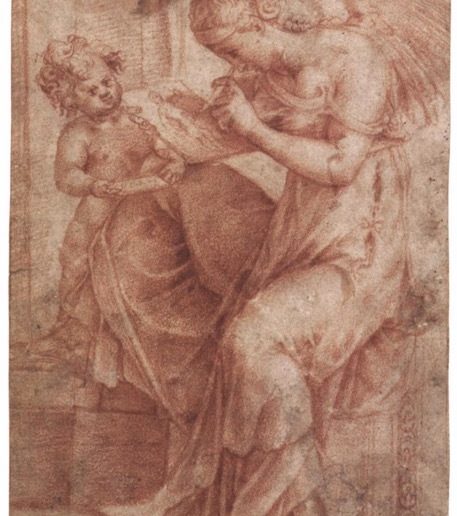Pirro Ligorio
Female Winged Figure Drawing in the Company of a Putto (Study for an Allegory of Painting)
Ca. 1550s
Red chalk
18.5 x 12.5 cm
On loan from the Tobey Collection
Pirro Ligorio was an artist accomplished in many areas, including painting, architecture, and drawing. Ligorio served as the Vatican Papal Architect under two Popes – Paul IV and Pious IV. Ligorio’s work, with an evident admiration for ancient Greek and Roman art, embodies the essence of the Italian Renaissance. In this work, we see two classical-looking figures: a winged woman and what art historians call a “putto.” “Putto” is the term used to describe a representation of a naked child; such figures are often found in both ancient and Renaissance images. The viewer might at first assume the woman is a Christian angel, but, on second glance, it can be seen that the winged woman is a draftswoman, and the putto is holding up a small card that is perhaps inspiring her work. The woman here is a personification, a human figure that stands for an idea—in this case, the idea of painting itself.
As is the case with much Renaissance art, Ligorio has attempted to create an idealized scene that also appears naturalistic. The woman is seated convincingly on a stony ledge with one foot on the ground, and the other upon the ledge. She props her painting surface on her raised knee. This creates a very natural-looking position as, in real life, many people might choose such a position while drawing.
Aside from the figures themselves, the most visually-stimulating aspect of this work is the light red hue of the chalk. Female Winged Figure Drawing in the Company of a Putto is executed in red chalk in a technique sometimes called sanguine drawing. “Sanguine” comes from the Latin word sanguis, meaning blood, and the tint gives a natural-seeming pigment to the characters’ skin. Chalk gives a less distinct line than ink, and, here, the slightly pinkish undertones and the delicate blur of the chalk create a very organic and natural aesthetic, giving the pleasing illusion of softness, especially appealing on skin, cloth, hair, and feathers.
John Briggs

